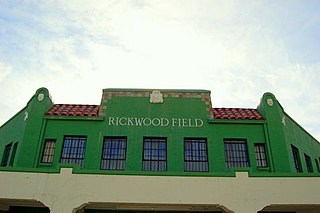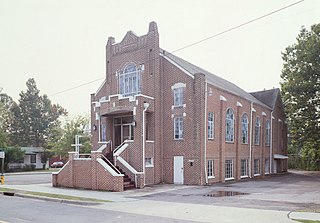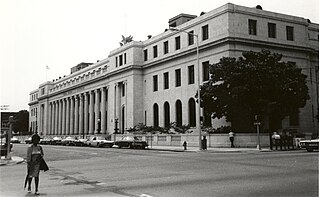
Rickwood Field, located in Birmingham, Alabama, is the oldest existing professional baseball park in the United States. It was built for the Birmingham Barons in 1910 by industrialist and team-owner Rick Woodward and has served as the home park for the Birmingham Barons and the Birmingham Black Barons of the Negro leagues.

The Alabama Theatre is a movie palace in Birmingham, Alabama. It was built in 1927 by Paramount's Publix Theatres chain as its flagship theater for the southeastern region of the United States. Seating 2,500 people at the time, it was the largest in the Birmingham theater district. The district was once home to many large theaters and movie palaces that featured vaudeville, performing arts, nickelodeons and Hollywood films. Built to show silent films, the Alabama still features its original Wurlitzer theater organ. The Alabama Theatre and Lyric Theatre are the district's only remaining theaters, and as of 2024, both are in operation.

Sloss Furnaces is a National Historic Landmark in Birmingham, Alabama in the United States. It operated as a pig iron-producing blast furnace from 1882 to 1971. After closing, it became one of the first industrial sites in the U.S. to be preserved and restored for public use. In 1981, the furnaces were designated a National Historic Landmark by the United States Department of the Interior.

The 16th Street Baptist Church is a Baptist church in Birmingham, Alabama, United States. In 1963, the church was bombed by Ku Klux Klan members. The bombing killed four young girls in the midst of the Civil Rights Movement. The church is still in operation and is a central landmark in the Birmingham Civil Rights District. It was designated as a National Historic Landmark in 2006. Since 2008, it has also been on the UNESCO list of tentative World Heritage Sites.
The Seth Lore and Irwinton Historic District is a historic district in Eufaula, Barbour County, Alabama, United States. It was listed on the National Register of Historic Places in 1973 as Lore Historic District; the registration document identified and described 72 specific buildings. And then its boundaries were increased and the district was renamed to "Seth Lore and Irwinton Historic District" in 1986; the entire area then contained 738 contributing buildings.

Bethel Baptist Church is a Baptist church in the Collegeville neighborhood of Birmingham, Alabama. The church served as headquarters from 1956 to 1961 for the Alabama Christian Movement for Human Rights (ACMHR), which was led by Fred Shuttlesworth and active in the Birmingham during the Civil Rights Movement. The ACMHR focused on legal and nonviolent direct action against segregated accommodations, transportation, schools and employment discrimination. It played a crucial role in the 1961 Freedom Rides that resulted in federal enforcement of U.S. Supreme Court and Interstate Commerce Commission rulings to desegregate public transportation.
Woodward Building may refer to:

The Elwood Bar was built in 1936 at 2100 Woodward Avenue in Detroit, Michigan and is now located at 300 East Adams Street. The name comes from a combination of the cross streets: (El)izabeth and (Wood)ward. The building was listed on the National Register of Historic Places in 1985.

The Religious Structures of Woodward Avenue Thematic Resource (TR) is a multiple property submission to the National Register of Historic Places which was approved on August 3, 1982. The structures are located on Woodward Avenue in the cities of Detroit and Highland Park, Michigan.

The Midtown Woodward Historic District is a historic district located along Woodward Avenue in Detroit, Michigan. Structures in the district are located between 2951 and 3424 Woodward Avenue, and include structures on the corner of Charlotte Street and Peterboro Street. The district was admitted to the National Register of Historic Places in 2008.

The Dwight Street Historic District is an irregularly shaped 135-acre (55 ha) historic district in New Haven, Connecticut. The district is located immediately west of the center of Downtown New Haven and is generally bounded by Elm Street on the north, Park Street on the east, North Frontage Road on the south, and Sherman Avenue on the west. It contains one of the city's highest concentrations of well-preserved 19th and early 20th-century residential architecture, much of which was developed for the working classes in the city's factories. It was listed on the National Register of Historic Places in 1983. The historic district includes most of the Dwight neighborhood and several blocks of the northeast corner of the West River neighborhood.

The Robert S. Vance Federal Building and United States Courthouse, previously known as the U.S. Post Office and Federal Building & Courthouse, is located at 1800 5th Avenue North in Birmingham, Alabama. The Beaux-Arts-style building was constructed in 1921. It served historically as a courthouse of the United States District Court for the Northern District of Alabama, and as a post office. It was listed on the National Register of Historic Places on June 3, 1976. It is still in use by the U.S. Bankruptcy Court for the Northern District of Alabama.

The Bridge Avenue Historic District is located in a residential neighborhood on the east side of Davenport, Iowa, United States. It has been listed on the National Register of Historic Places since 1983. The historic district stretches from River Drive along the Mississippi River up a bluff to East Ninth Street, which is near the top of the hill.

Canaan Baptist Church is a Baptist church located in Bessemer, Alabama. It is affiliated with the National Baptist Convention, USA. Built in 1961, it had a congregation active in the Civil Rights Movement of the 20th century and was added to the National Register of Historic Places in 2005.

The Morris Avenue Historic District is an industrial district in Birmingham, Alabama. The district covers Morris Avenue from 20th Street to 25th Street and First Avenue from 21st to 26th Street. The Morris Avenue section comprises a set of late 19th century masonry warehouses that were Birmingham's main food distribution center until the 1950s. The First Avenue section of the district comprises a mixed neighborhood of late 19th century offices and warehouses, built shortly after the Morris Avenue development. The combined areas include 63 contributing structures, of the 69 buildings in the district. Notable buildings include the Liberty Trouser Building and the A.C. Legg Building on Morris Avenue on either side of the Moskowitz Warehouse. On First Avenue the Birmingham Realty Building and the A.A. Adams Realty Building, as well as the Goodall-Brown Building are notable.

The Automotive Historic District in Birmingham, Alabama, is a 42-acre (17 ha) historic district roughly bounded by First Avenue North, 24th Street South, Fifth Avenue South, and 20th Street South. It was listed on the National Register of Historic Places in 1991. At the time of listing, the district included 119 contributing buildings and four contributing structures.

William C. Weston was a New Zealand-born American architect. Weston practiced architecture in Birmingham, Alabama from 1901 until 1915 and in Detroit until his death in 1932.

The Fourth Avenue Historic District in Birmingham, Alabama was listed on the National Register of Historic Places in 1982. The listing included 17 contributing buildings on 4.2 acres (1.7 ha). It includes the 1600-1800 blocks of 4th Ave., N. and part of the 300 blocks of 17th and 18th Sts., N.

The Woodlawn Commercial Historic District, in Birmingham, Alabama, was listed on the National Register of Historic Districts in 1991. It is a 6 acres (2.4 ha) district which included 12 contributing buildings and four non-contributing buildings in an area around the junction of 1st Avenue North and 55th Place in Birmingham, at the center of the community of Woodlawn, Alabama, which for a time was a separate city before being absorbed into Birmingham. A much larger portion of the community, including all of this Commercial historic district and residential areas as well, was later listed on the National Register as Woodlawn Historic District.
Woodlawn, Alabama is a community in Jefferson County, Alabama, which is now a neighborhood within the city of Birmingham, Alabama. It grew as an independent community, and became the City of Woodlawn, and built a substantial City Hall building in 1908, but was annexed by Birmingham in 1910. The community area experienced a surge of growth after it was annexed.
























